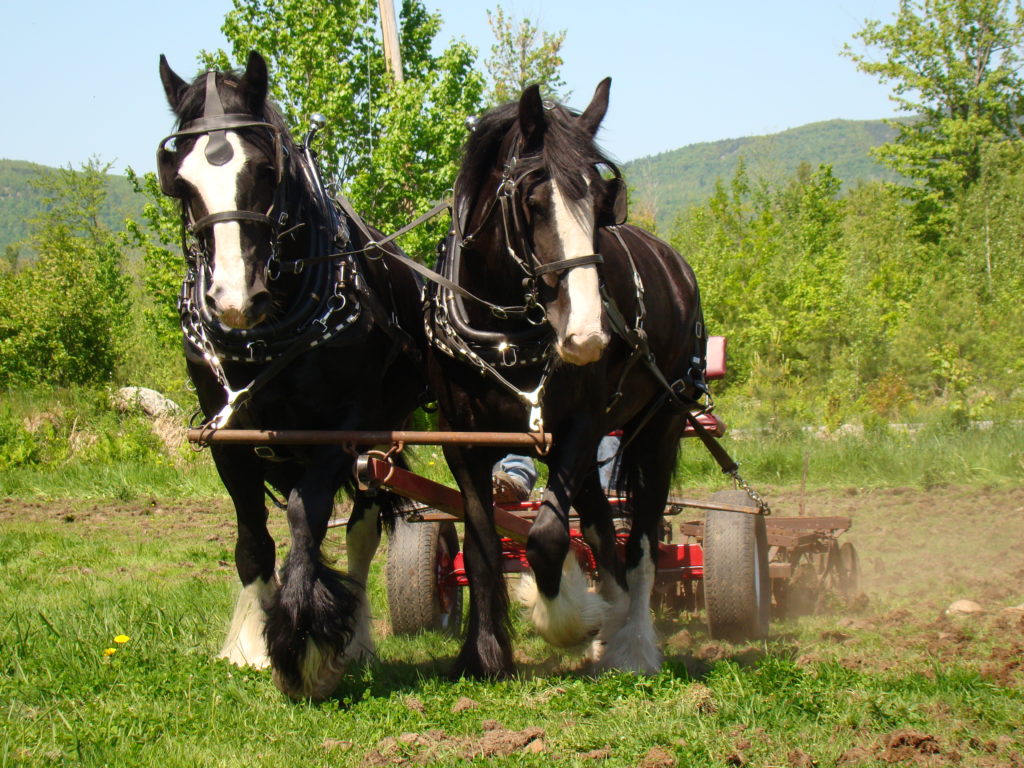Choosing a draft horse means matching the horse to the job
Long before there were mechanized tractors and trucks, the heavy lifting and pulling on farms and homesteads was done by teams of draft horses.
Draft horses are the largest of the equine breeds and can supply the power to pull and operate machinery to till, plant and harvest the land.

For farmers today who want to go back to literal horsepower, there are a few things to consider in choosing a draft horse.
Know your goals and limitations
Vicki Schmidt owns and loves draft horses and is a member of the Maine Draft Horse Association. She said people need to be realistic on why they want a draft horse in the first place before they go shopping for one.
“Choosing any horse, especially a draft, begins with knowing your goals,” Schmidt said. “Do you want to show [the horse], go logging [or] have an all around farm draft horse?”
It’s also important to be realistic with the amount of money you can budget for purchasing and caring for the horse, Schmidt said.
Breeds like Clydesdales or Shires tend to be more rare than others and thus carry a higher price tag.
If you plan to use the draft horse for active farm work that requires specialized horseshoes, keep in mind that farriers — professionals who can trim horse hooves and shoe them — can be difficult to find in the modern age.
“It would be a good idea to make sure you live in an area well serviced by a draft farrier,” Schmidt said.
Draft horse breeds
A draft horse can weigh more than 1,600 pounds and stand up to seven-feet tall at their shoulders. They are heavy-boned and extremely muscular.
They also tend to be good-natured, ready to learn, eager to please and make as good companion animals as they do beasts of burden.
While specific breeds of draft horses were developed over time for specific jobs, Schmidt said the individual horse is more important than the breed.
“There are good and not good [horses] in all breeds of drafts,” she said. “A good horse is never the wrong color or breed.”
But when choosing a draft horse, knowing a bit about individual breeds that are still found in North America can help you get started.
Shire – For pure pulling power and strength, nothing beats a Shire draft horse. It’s an ancient breed originating in Great Britain and was once used extensively for pulling carts of ale from the breweries to pubs.
Percheron — Well muscled and among the more clever of the draft horses, Percherons have a strong reputation for their willingness to work and their good nature. They are equally good for farm work and for pulling sleighs or wagons.
Belgian — This draft horse is known for having a friendly temperament and being easy to handle. They are a good all around horse suitable for plowing, tilling, logging, pulling carriages and even riding.
Clydesdale – Probably the most recognized of the draft horse breeds, thanks in large part to the role they have on national beer commercials, Clydesdales are another all around draft horse. They are good for farming, logging, riding and as good companions.
The benefits of a draft horse
Draft horses started making a limited comeback on the American agriculture scene in the 1970s when the cost of petroleum fuel began to rise, according to information published by the Eastern Draft Horse Association.

While they can’t compete with a mechanized tractor in large-scale farming, draft horses can be a practical alternative in smaller or specialty farming.
In logging, for example, using draft horses to haul lumber has less of an impact on the forest floor and soil than heavy logging machinery. Smaller and able to navigate their way around trees, draft horses also make it easier to conduct selective tree harvesting.
Not always the best choice
Despite the many farm or homestead tasks draft horses are capable of, they are not always the best option.
“They are not for everyone,” Schmidt said. “They require more space and feed than a typical light horse and not all draft [horses] are physically suited to or enjoy the variety of activities enjoyed by equine enthusiasts.”
Ultimately, it comes down to what you want the horse to do for you as you decide how to choose a breed and finding that perfect match.
“Buy the horse,” Schmidt said. “Not the breed.”
